20 Front of House Flower Bed Ideas to Instantly Boost Curb Appeal
Your home’s exterior is the first impression guests and neighbors get—and nothing enhances curb appeal quite like a thoughtfully designed flower bed. Whether you’re working with a modest front yard or a sweeping lawn, flower beds add color, texture, and personality to your outdoor space. The right combination of blooms, greenery, and edging can make your home feel welcoming and well cared for all year round.
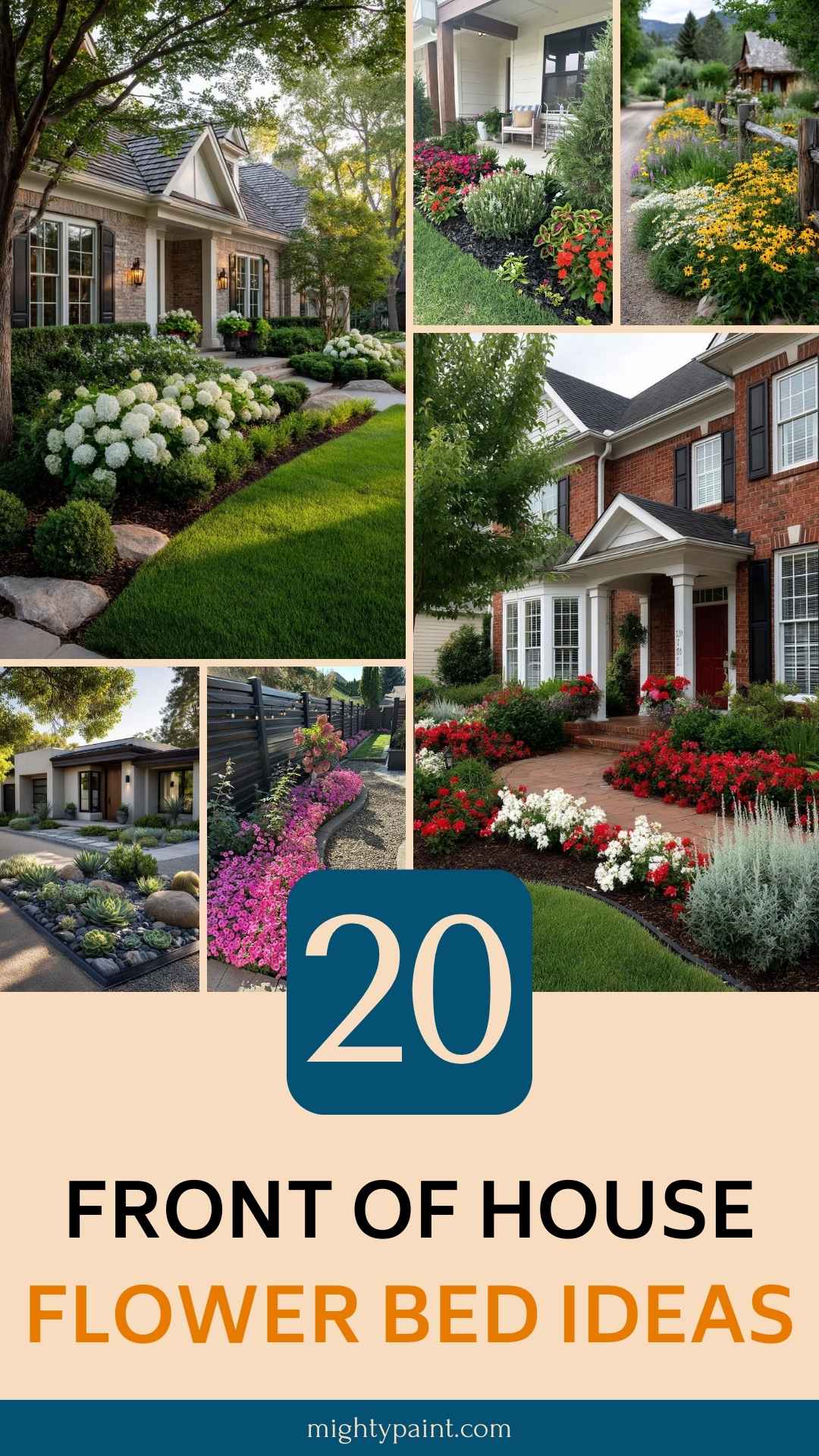
From neat, low-maintenance layouts to lush, layered designs, there are endless ways to showcase your style through your front garden. You don’t need to be a professional landscaper, either. With a little planning and inspiration, you can create a front yard flower bed that elevates your home’s aesthetic and even increases its value.
Get the Fail-Safe Paint Color Playbook (Free PDF)
36 proven colors • 8 ready palettes • trim & sheen guide • printable testing cards.
In this listicle, we’ll explore 20 stunning front of house flower bed ideas—from simple border gardens to vibrant focal points—that will help your home bloom with charm and character.
1. Curved Border Bed with Pink Petunias for a Vibrant Walkway
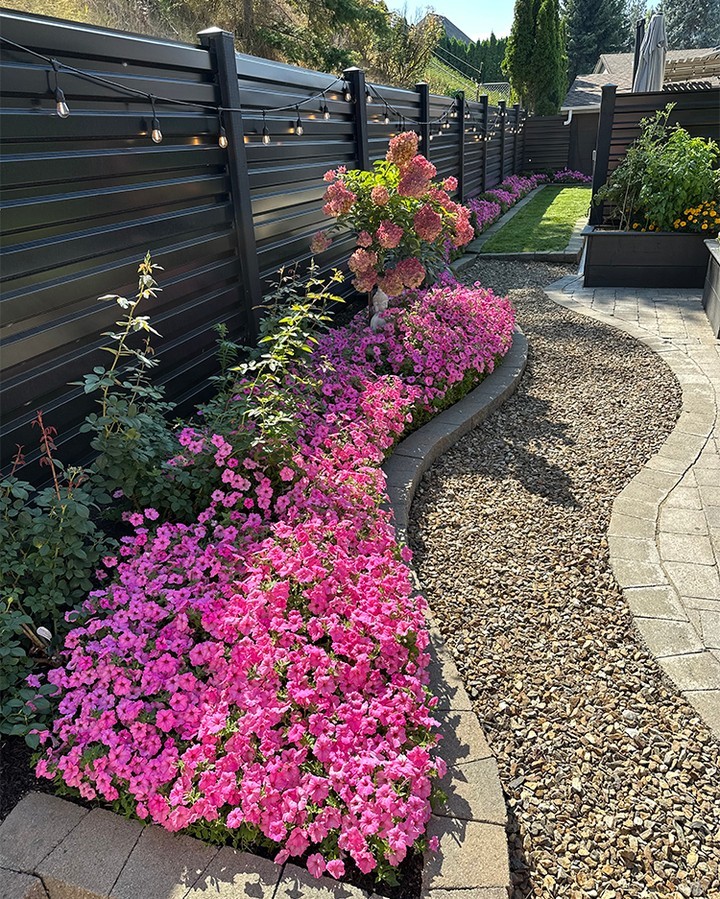
Create a visually stunning front yard experience with a curved border flower bed filled with bold pink petunias. This design combines structure and softness—the gently winding stone edging gives the bed definition, while the mass of low-growing blooms provides a lush, inviting carpet of color. Petunias are a front yard favorite because of their long blooming season and ability to fill in spaces quickly with minimal upkeep.
The layered planting approach, with taller shrubs like hydrangeas placed sporadically along the edge, adds depth and height variation, preventing the bed from looking flat. Decorative gravel alongside the flower bed enhances the clean lines while offering excellent drainage and weed control. Ideal for lining walkways, driveways, or fences, this flower bed design boosts curb appeal with both elegance and ease.
2. Layered Porch Bed with Evergreens and Bright Annuals

Framing your front porch with a layered flower bed is a surefire way to create a warm and inviting entrance. This design combines tall evergreens for year-round structure with a vibrant mix of annuals like impatiens and begonias that burst with seasonal color. The dark mulch creates a crisp contrast that makes the reds, pinks, and greens pop while helping to retain moisture and suppress weeds.
A variety of textures—from soft coleus leaves to spiky salvia blooms—adds visual richness and keeps the flower bed interesting from every angle. The staggered height arrangement ensures that nothing is hidden, creating a full, lush appearance that complements the home’s porch and architectural details. This type of flower bed is ideal for homeowners who want something cheerful and colorful, yet tidy and easy to maintain throughout the growing season.
3. Tropical-Inspired Flower Bed with Palm Trees and Bold Blooms
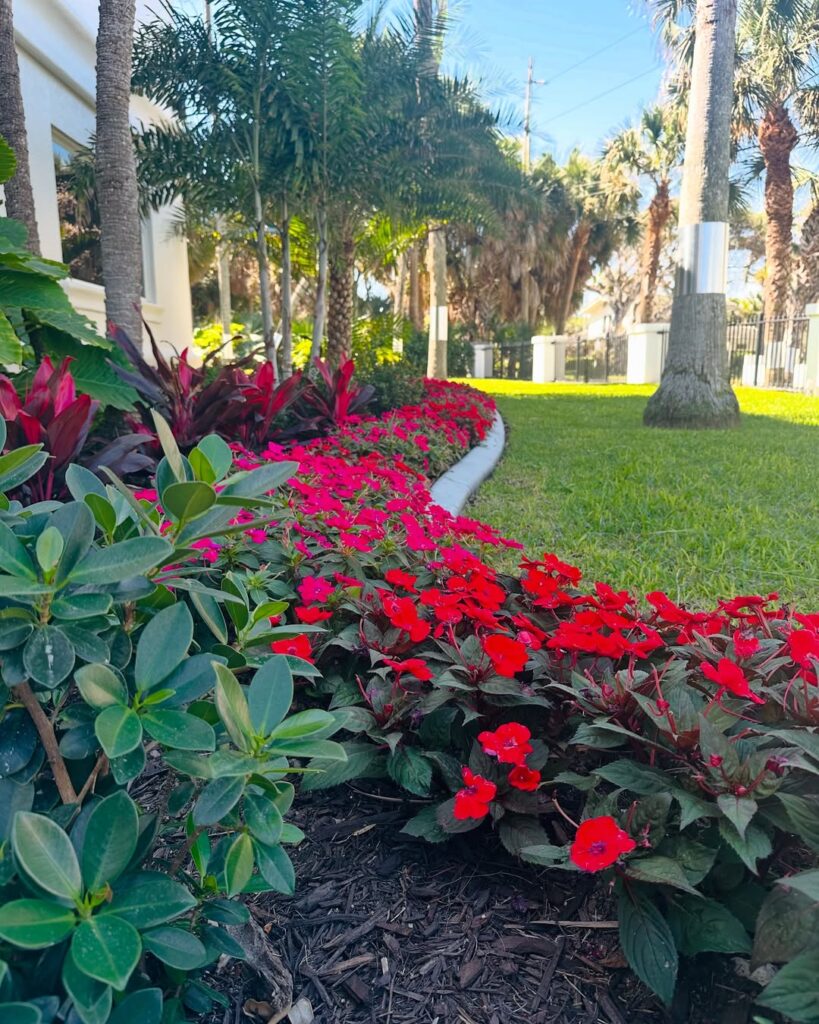
Turn your front yard into a lush, tropical escape with a flower bed design that pairs towering palms with a vibrant underlayer of red and magenta flowers. This tropical-inspired layout brings bold color and exotic flair, perfect for homes in warmer climates or anyone craving a resort-like feel right at their doorstep.
A tidy concrete edge defines the border, while dense plantings of impatiens and ti plants provide a continuous burst of color. The layering of dark mulch and glossy green foliage further enhances the tropical aesthetic and offers excellent contrast for the bright blossoms. Positioned along the front walkway or the base of your house, this flower bed style feels both dramatic and intentional—instantly upgrading curb appeal with a bold, vacation-ready vibe.
4. English Cottage-Style Flower Bed with Layered Blooms
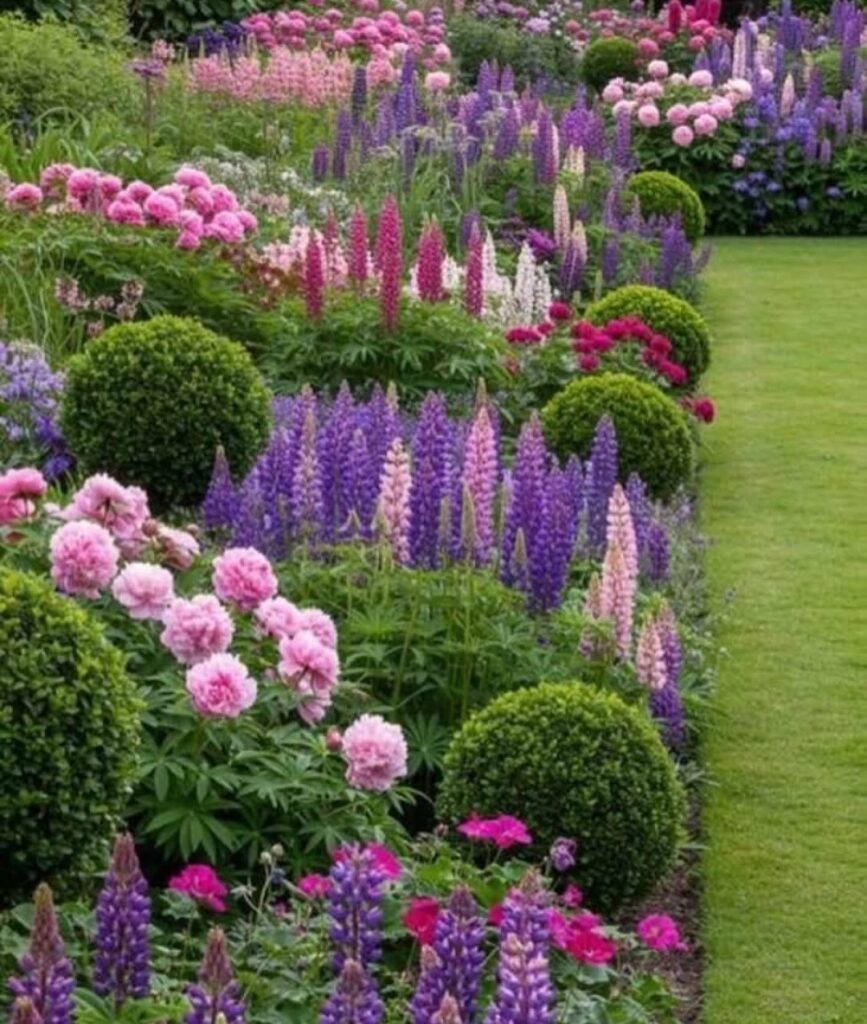
Channel classic charm and timeless beauty with an English cottage-style flower bed filled with dense, colorful layers of blooms. This design showcases a romantic palette of purples, pinks, and soft whites using perennial favorites like lupines, peonies, and roses, all complemented by perfectly clipped boxwood spheres for structure.
The staggered heights and overlapping planting style give the garden a natural, overflowing look that feels both lush and curated. It’s ideal for larger front yards where you want to create an immersive garden path or border along the lawn. The balance of loose florals and formal topiary shapes keeps the composition elegant while allowing the natural beauty of each plant to shine. This flower bed idea is perfect for homeowners who love traditional garden aesthetics and want their front yard to make a graceful, storybook-worthy impression.
5. Tulip-Filled Flower Beds with Natural Stone Accents
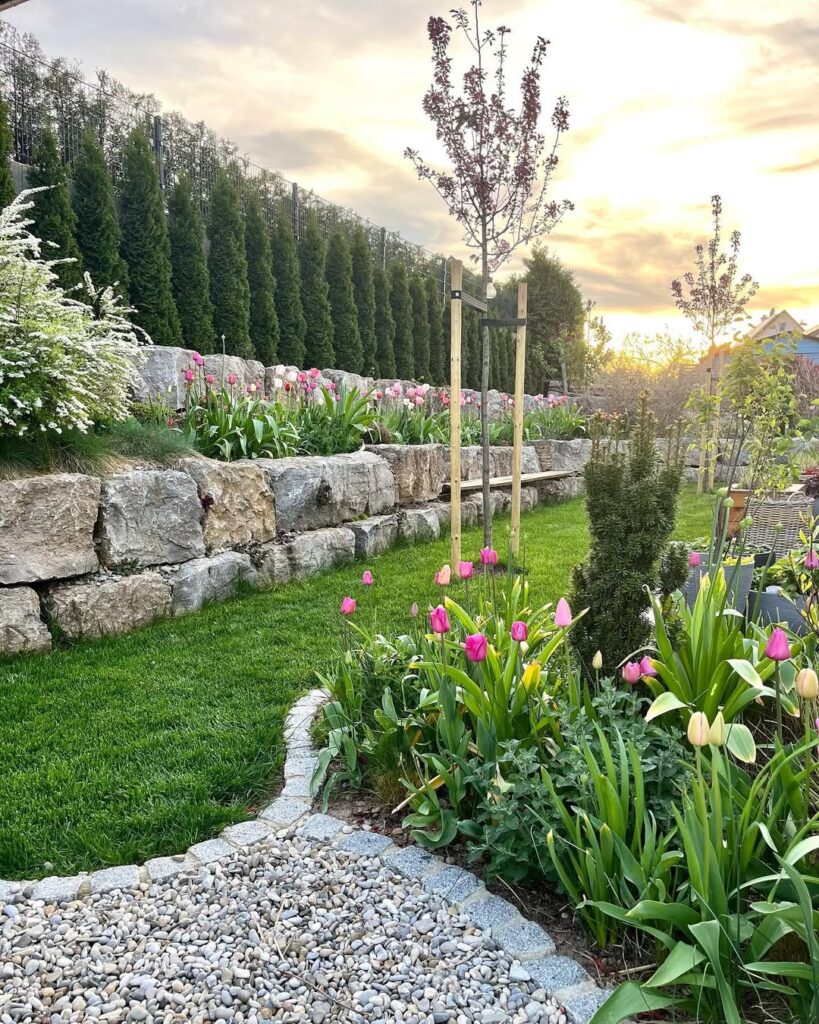
Add elegance and seasonal flair to your front yard with tulip-filled flower beds framed by natural stone. This design showcases neat layers of blooming tulips—both in a central curved bed and along a raised stone wall—creating visual depth and a vibrant springtime focal point. The varied shades of pink, purple, and yellow tulips bring cheerful color that feels refined yet playful.
Natural stone edging and retaining walls lend a rustic, organic feel while maintaining structure and definition in the landscape. Paired with gravel pathways and freshly mown lawn, the overall look is clean, polished, and low-maintenance. This style works especially well for homes on sloped lots or with tiered landscaping, making great use of elevation and adding dimension to the front yard. It’s a picture-perfect choice for those who love seasonal blooms and natural materials in harmony.
6. Symmetrical Flower Beds for a Formal Look

If you’re looking to add elegance and structure to your front yard, symmetrical flower beds are a classic choice. This design involves mirroring the same plants, shapes, and layout on either side of a walkway, entry path, or porch. The balanced appearance gives your home a stately, organized look that instantly enhances curb appeal.
Begin with anchor plants like boxwood or dwarf spruce on both sides, then layer in flowering perennials such as hydrangeas, peonies, or daylilies for seasonal color. Ground cover like creeping thyme or ajuga adds texture and helps suppress weeds. Using mulch or decorative edging stones reinforces the symmetry and keeps the space tidy.
Get the Fail-Safe Paint Color Playbook (Free PDF)
36 proven colors • 8 ready palettes • trim & sheen guide • printable testing cards.
Symmetrical flower beds are particularly well-suited for Colonial, Georgian, or traditional-style homes. They’re easy to maintain once established, and their visual consistency creates a polished entryway that appeals to guests and potential buyers alike.
7. Cottage-Style Flower Beds for a Whimsical Touch

Cottage-style flower beds offer a relaxed, romantic aesthetic filled with layered textures, vibrant colors, and abundant blooms. These beds are often informal in shape—curved or freeform rather than straight—and packed with a variety of flowering plants that bloom at different times for a continuous show of color.
Common cottage garden flowers include foxgloves, delphiniums, coneflowers, hollyhocks, and daisies. Intermixing herbs like lavender and rosemary not only adds fragrance but also attracts pollinators. The key is to create an artful “controlled chaos” by mixing heights, hues, and textures to mimic a naturalistic look.
This style is ideal for homes with a charming, vintage, or farmhouse vibe. It’s perfect for gardeners who enjoy a more organic approach and want to infuse their front yard with personality, color, and old-world charm.
8. Low-Maintenance Perennial Beds

For homeowners who want beauty without the constant upkeep, low-maintenance perennial beds are a smart solution. Perennials return year after year, minimizing the need for seasonal replanting. Choose hardy, drought-tolerant varieties that thrive in your climate, such as black-eyed Susans, sedum, Russian sage, and ornamental grasses.
Arrange plants based on their mature height, placing taller species in the back and shorter ones up front. Add mulch to retain moisture, suppress weeds, and improve soil health. Drip irrigation or soaker hoses can make watering more efficient.
Low-maintenance flower beds are ideal for busy homeowners, rental properties, or those new to gardening. They offer long-term color and structure with minimal input, making them both beautiful and practical.
9. Raised Flower Beds for Visual Impact

Raised flower beds are a stylish and practical option that can add instant dimension and definition to your front yard. Constructed using wood, stone, brick, or concrete blocks, these beds elevate plants off the ground, drawing attention to the landscaping and making maintenance easier on your back.
One of the main benefits of raised beds is improved drainage and soil control. You can tailor the soil composition to suit specific plant types, from acid-loving azaleas to lush hydrangeas. This design also helps keep pests like rabbits and ground insects at bay. Raised beds can be square, rectangular, or even curved to complement your home’s architecture.
Use a mix of flowering plants and greenery for balanced interest—think petunias, coleus, begonias, and ferns. Border the beds with cascading flowers like sweet alyssum or trailing lobelia for added charm. Ideal for modern and traditional homes alike, raised beds make a strong visual statement while being practical and customizable.
10. Evergreen Foundation Beds
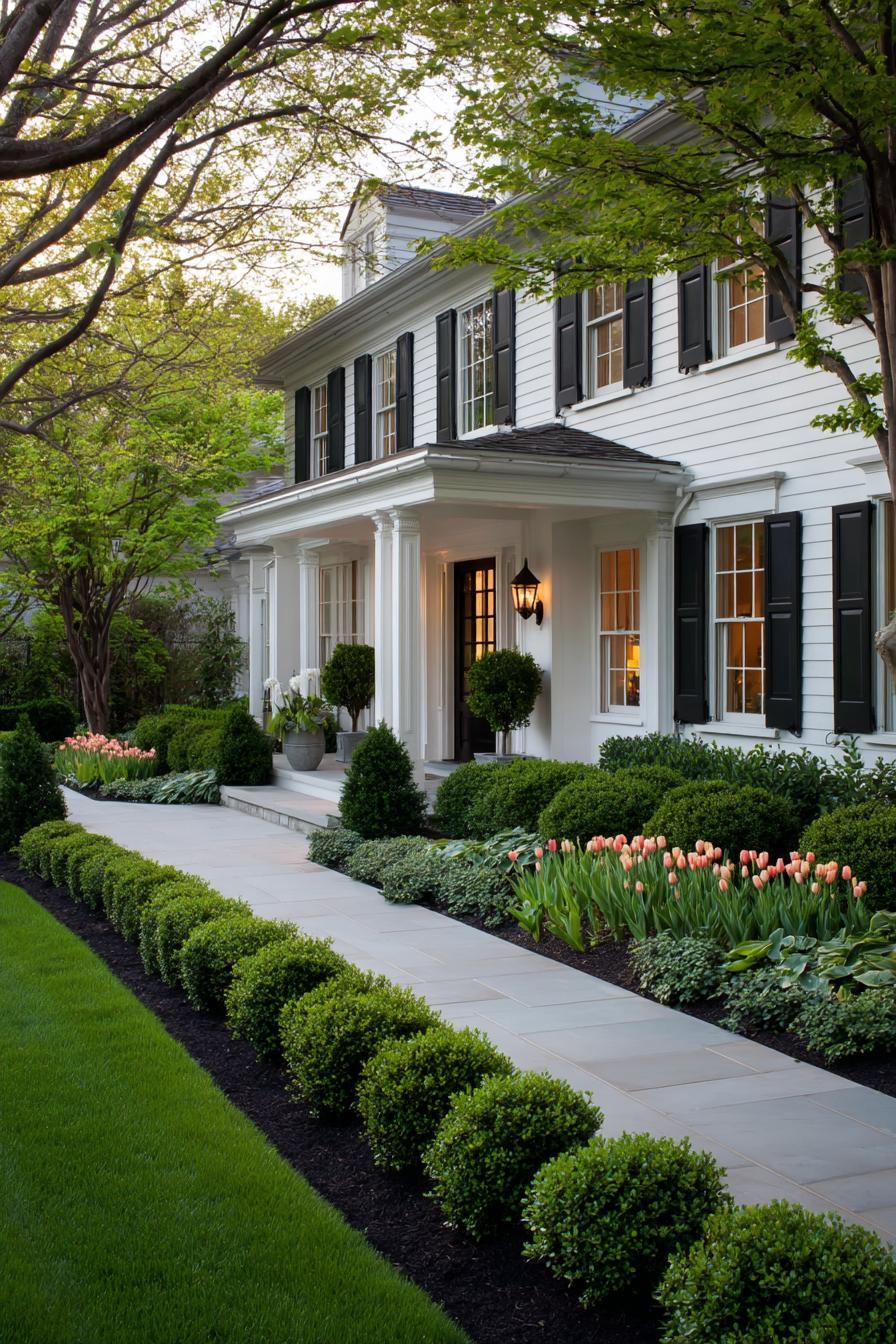
Foundation flower beds filled with evergreen shrubs and perennial flowers provide a year-round structure and curb appeal. These beds are typically placed directly along the base of your home, softening architectural lines and adding a welcoming feel to your exterior.
Get the Fail-Safe Paint Color Playbook (Free PDF)
36 proven colors • 8 ready palettes • trim & sheen guide • printable testing cards.
Start with low-maintenance evergreens like boxwood, dwarf spruce, or Japanese holly as your backbone. These plants offer color and form during every season. Layer in perennials such as hostas, coral bells, or salvia to add interest and seasonal variation. For a dynamic touch, consider adding spring bulbs like tulips or daffodils that will pop up through the evergreens for a burst of early color.
Foundation beds can be formal or informal, depending on plant choice and layout. With proper spacing and a well-mulched base, these beds are easy to maintain and give your front entry a polished, evergreen frame that’s attractive all year long.
11. Seasonal Flower Rotation Beds
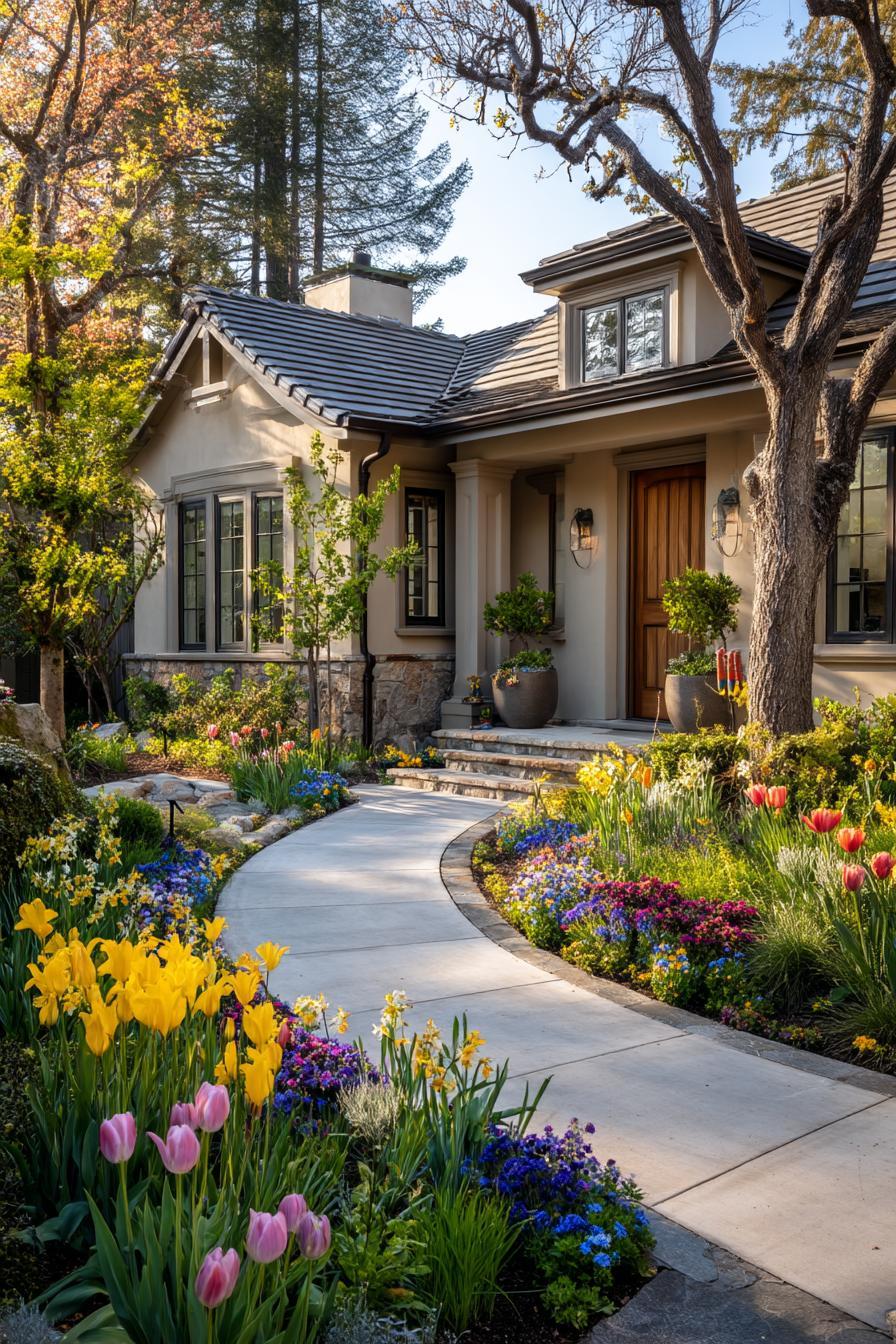
If you love variety and vibrant color throughout the year, seasonal flower rotation beds are a fantastic option. These beds are designed to accommodate new plantings every season, allowing you to experiment with different colors, textures, and flower types as the months change.
In spring, plant tulips, pansies, or daffodils. For summer, switch to zinnias, marigolds, petunias, or snapdragons. Fall can bring in chrysanthemums, ornamental kale, and asters, while winter may showcase evergreen topiaries or containers filled with pine boughs and berries.
These rotating beds are best suited for gardeners who enjoy the creative process and don’t mind seasonal replanting. They provide constant visual interest and allow your landscape to evolve throughout the year. When placed near walkways or entrances, seasonal beds create a lively and engaging first impression that reflects both your style and the beauty of the season.
12. Color-Themed Flower Beds
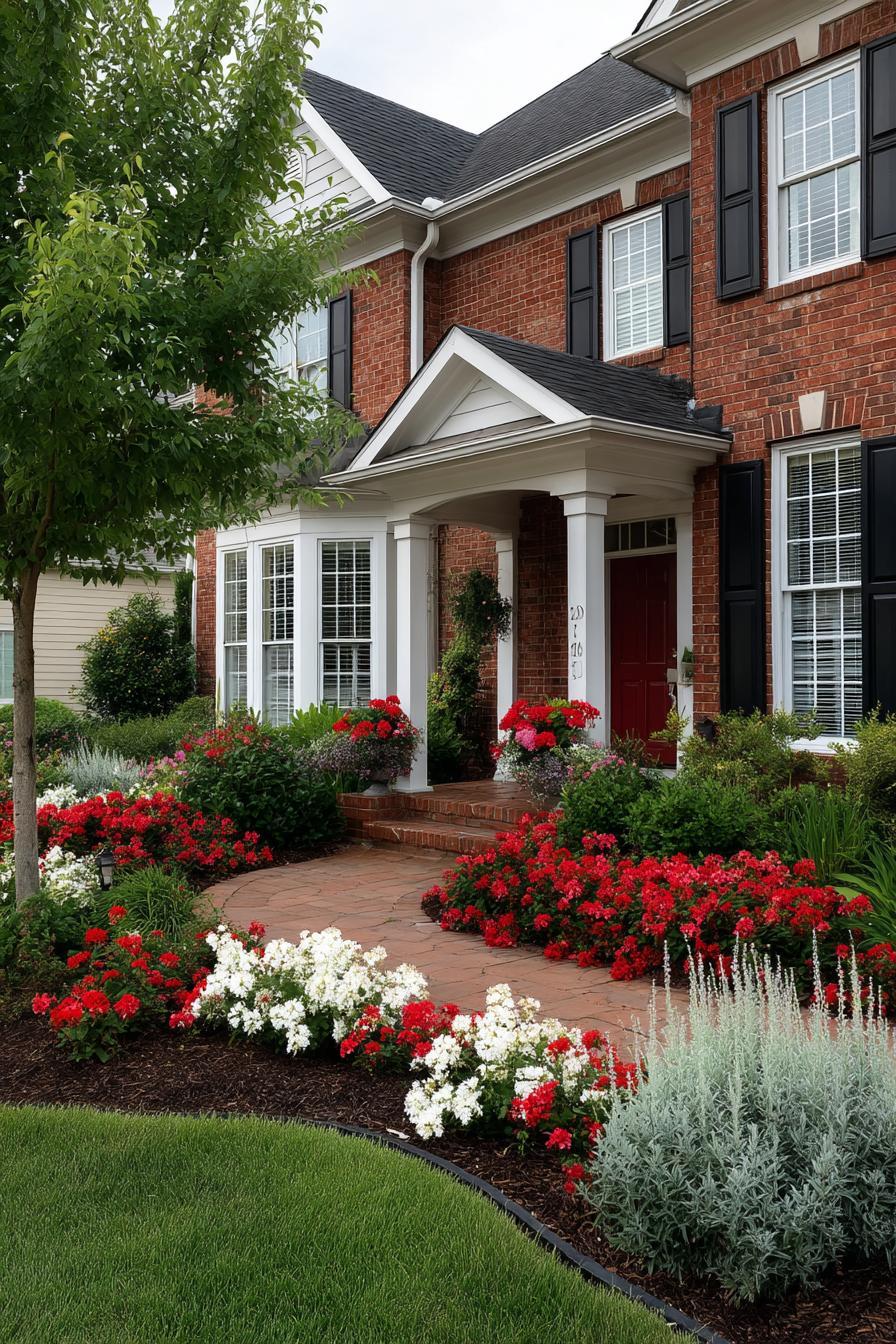
Color-themed flower beds are an easy yet striking way to make a design statement and unify your front yard’s aesthetic. By focusing on a single color family—or a specific combination like red and white or purple and yellow—you can create a cohesive and eye-catching look that ties in with your home’s exterior paint, trim, or front door.
To build a successful color-themed bed, choose a mix of bloom types, shapes, and bloom times to ensure variety and visual balance throughout the season. For example, a “white garden” might include white roses, daisies, petunias, and lamb’s ear, while a “sunset” theme could feature orange marigolds, coral snapdragons, and deep red coleus.
Color-centric beds are highly customizable and can be tailored to seasonal trends or personal preferences. They offer both simplicity and sophistication, making your front yard feel professionally designed and intentionally styled.
13. Wildflower-Inspired Beds for a Naturalistic Look

Wildflower-inspired beds bring a burst of untamed beauty to your front yard, creating the illusion of a natural meadow or prairie. These beds are characterized by loose planting styles, vibrant colors, and diverse plant species that mimic the spontaneity of wild landscapes.
Get the Fail-Safe Paint Color Playbook (Free PDF)
36 proven colors • 8 ready palettes • trim & sheen guide • printable testing cards.
Common wildflower selections include black-eyed Susans, coneflowers, yarrow, coreopsis, and blanket flowers. These native or hardy varieties attract pollinators and require less maintenance once established. Pair them with ornamental grasses like little bluestem or feather reed grass to add movement and seasonal variation.
Wildflower beds are ideal for homeowners seeking a low-maintenance, eco-friendly approach. They look especially fitting in cottage-style homes or rural properties, but with careful planning and edging, they can also enhance more suburban and modern spaces. These beds bloom in waves, offering evolving color and texture throughout the growing season while supporting local biodiversity.
Get the Fail-Safe Paint Color Playbook (Free PDF)
36 proven colors • 8 ready palettes • trim & sheen guide • printable testing cards.
14. Succulent Flower Beds for a Drought-Tolerant Design
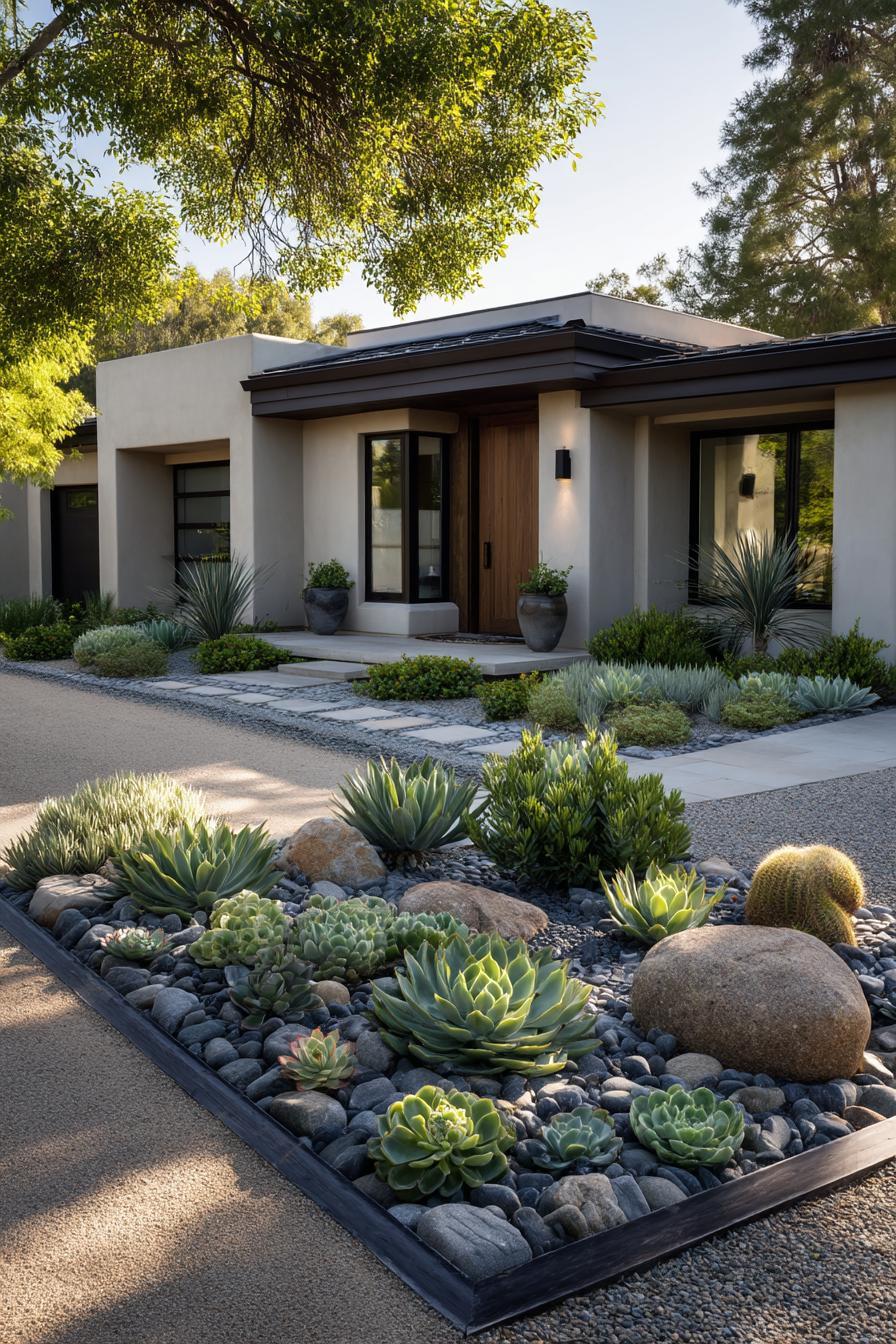
Succulent flower beds are perfect for front yards in hot, arid climates—or for homeowners seeking a modern, low-water landscape. These beds incorporate a mix of fleshy, drought-resistant plants like echeveria, sedum, hens and chicks, agave, and aloe vera. Their sculptural shapes and wide variety of colors and sizes create a visually captivating arrangement that’s also incredibly hardy.
To design a striking succulent bed, use rocks, gravel, or decomposed granite as mulch to help with drainage and give a clean, modern aesthetic. Group succulents with similar water and sunlight needs together, and add occasional pops of color with drought-tolerant blooms like California poppies or lantana.
Succulent beds require minimal watering and are virtually pest-free, making them ideal for xeriscaping or front yards where water conservation is a priority. Their architectural beauty and ease of care make them a smart, sustainable choice that still delivers high design impact.
15. Window Box Flower Beds
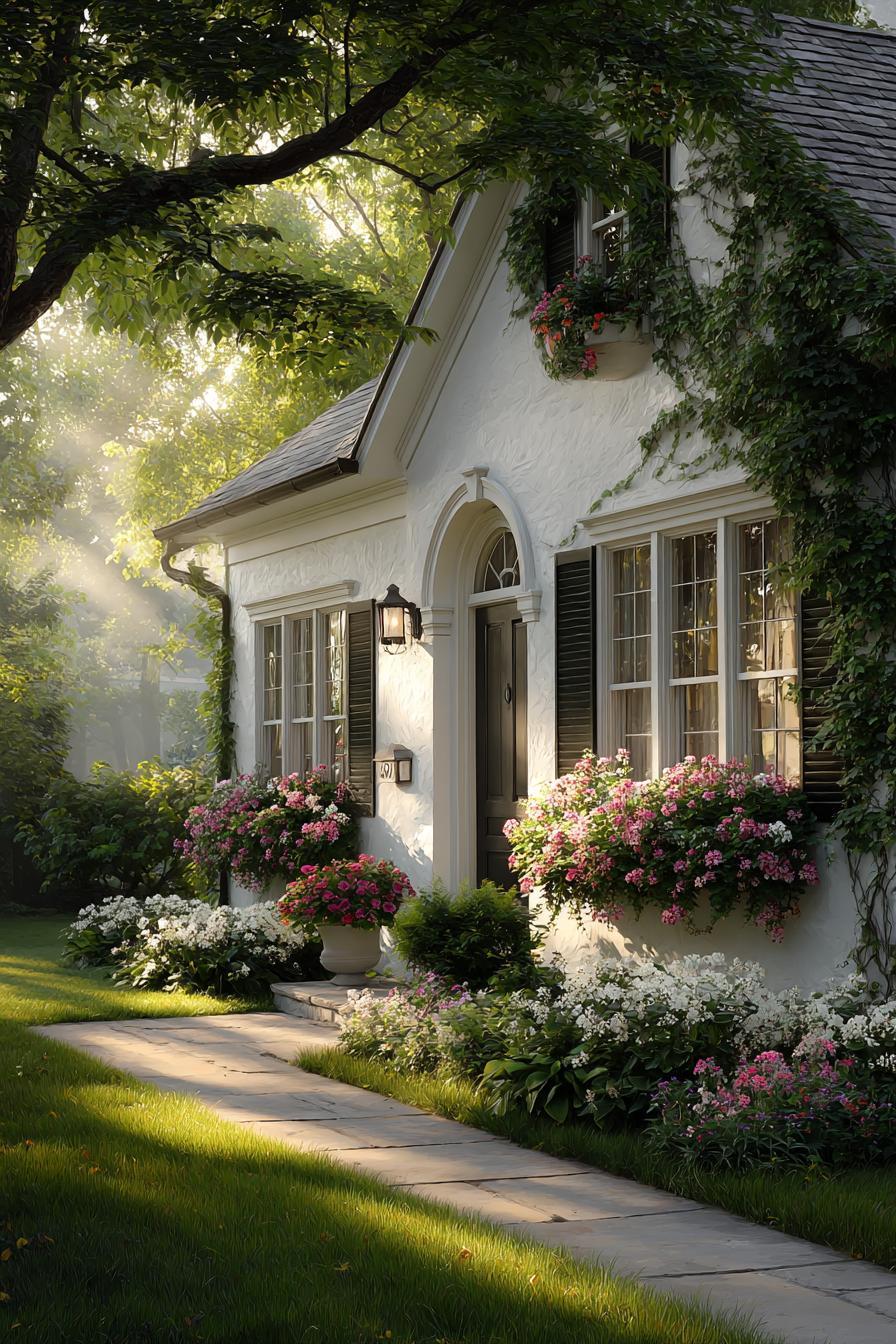
Window box flower beds offer a charming way to enhance curb appeal and bring blooms closer to eye level. Mounted beneath front-facing windows, these boxes allow you to enjoy vibrant, cascading flowers even in homes with limited yard space. They also create a layered effect when combined with ground-level beds, adding depth and visual interest to your home’s facade.
Choose trailing plants like petunias, ivy geraniums, or calibrachoa for the front edge, and mix in upright blooms like snapdragons or dwarf zinnias for height. Incorporate foliage plants like dusty miller or coleus for texture contrast. Be sure to coordinate colors with your exterior trim, siding, or shutters for a cohesive look.
Window boxes are easy to change seasonally, making them ideal for showcasing spring bulbs, summer blooms, fall mums, or winter greens. They’re low-maintenance, space-saving, and bring a personalized, welcoming touch to your front elevation.
16. Layered Flower Beds with Height Variations
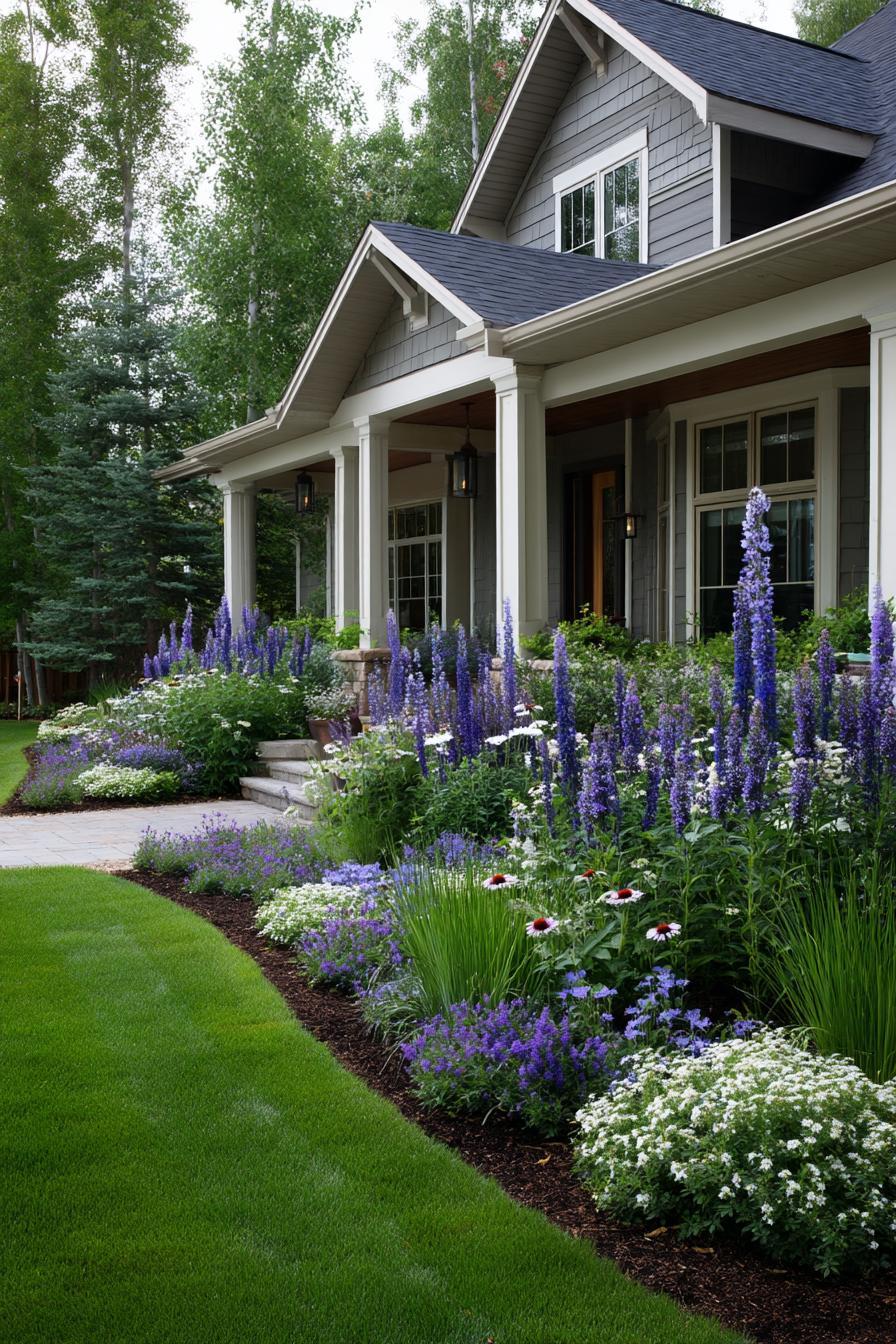
Layered flower beds add depth, drama, and a professional look to your front yard by arranging plants according to their height. The tallest plants are placed in the back (or center for island beds), mid-sized plants in the middle, and low-growing plants or ground covers along the front edge. This technique ensures visibility for all plants and creates a lush, tiered effect.
Begin with structural plants like tall ornamental grasses, delphiniums, or butterfly bushes. Mid-layer choices can include daylilies, echinacea, or salvias. For the front edge, go with spreading plants like creeping phlox, alyssum, or lobelia. Choose a cohesive color palette or complementary shades for maximum impact.
Layered beds work well against fences, porches, or house walls and provide a stunning visual transition from architecture to nature. They’re ideal for all garden styles—from traditional to contemporary—and help create year-round interest with smart plant selection.
17. Monochromatic Flower Beds
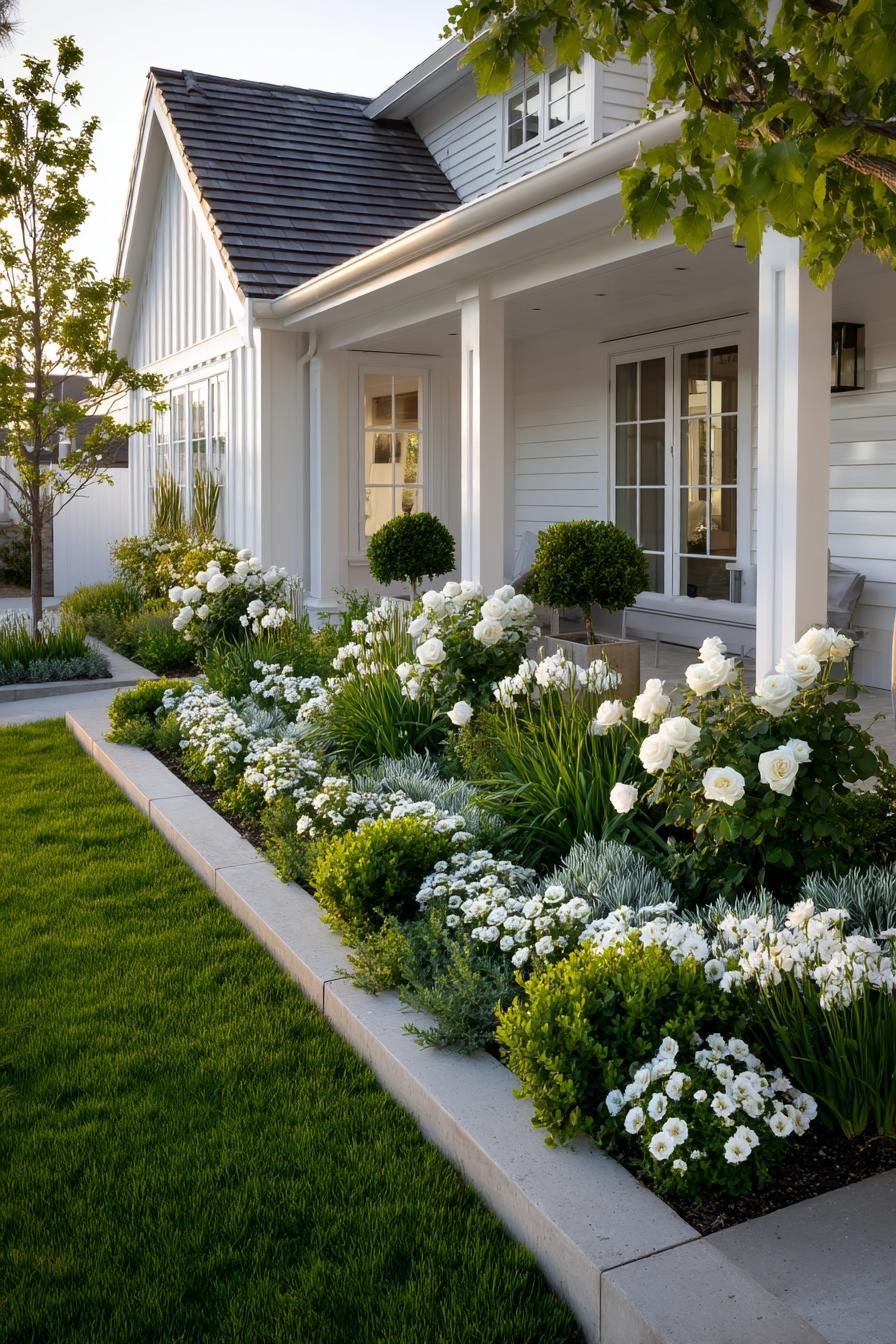
Monochromatic flower beds focus on one dominant color, creating a sleek, cohesive, and highly intentional design. Whether it’s shades of purple, all whites, or fiery reds and oranges, sticking to a single color family can unify your front yard’s appearance and make a bold design statement.
For example, a purple-themed bed could include lavender, salvia, verbena, and purple fountain grass. A white garden might showcase shasta daisies, white roses, alyssum, and dusty miller. The consistency of color provides calm and sophistication, especially when paired with structured edging or modern hardscape features.
Monochromatic beds are easy to design and maintain while delivering high visual impact. They suit both minimalist and traditional homes and offer a great way to highlight specific elements, like a colored front door or architectural feature.
18. Shade-Loving Flower Beds
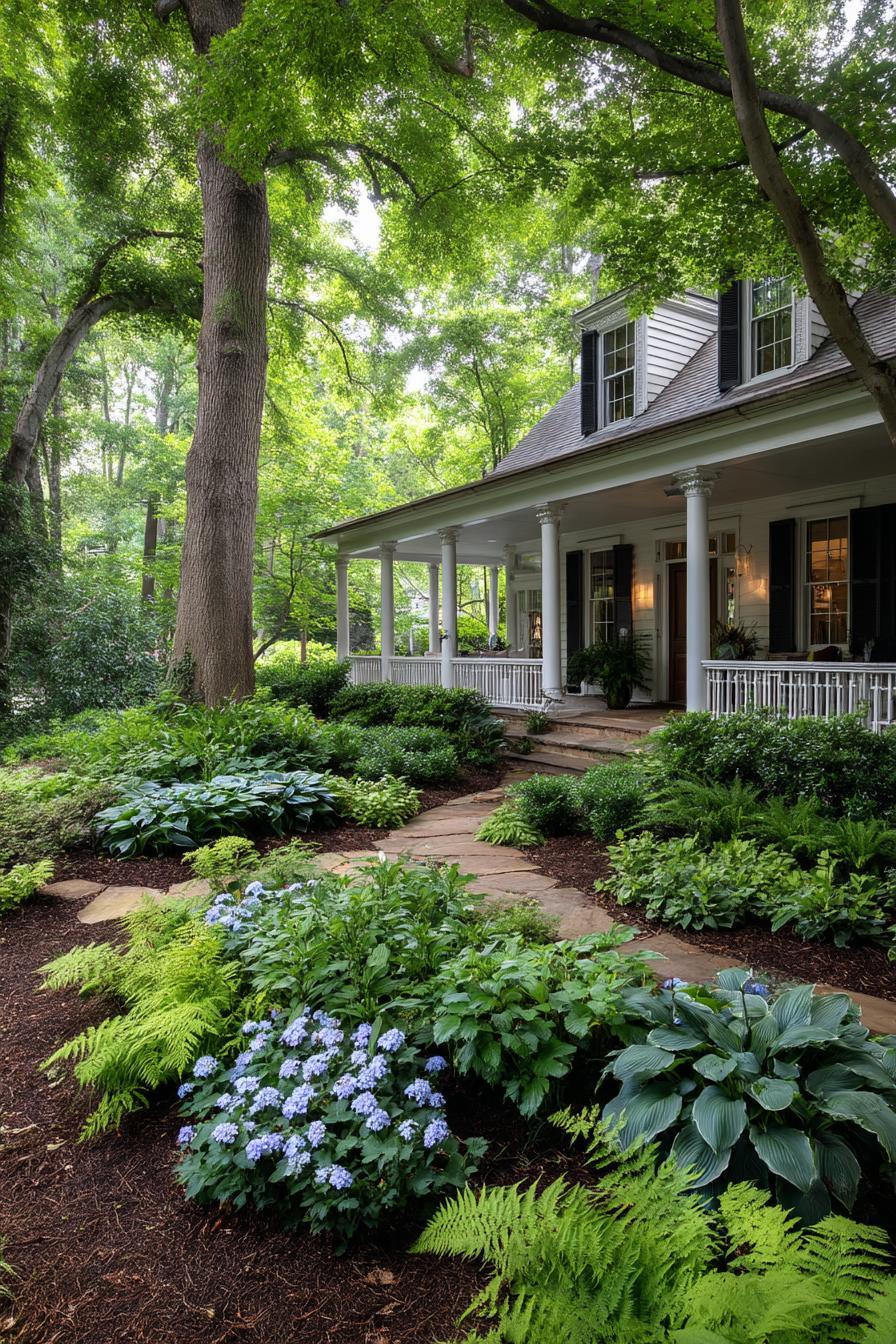
Not every front yard gets full sun, but that doesn’t mean you can’t have a stunning flower bed. Shade-loving beds are ideal for areas under trees, along the north side of a home, or beneath large porch overhangs. With the right plant selection, these areas can be just as colorful and lush as sunny spots.
Go for plants like impatiens, hostas, astilbe, ferns, and bleeding hearts. For added contrast, include foliage in various shades—like the silvery leaves of brunnera or the dark greens of hellebores. Mulch generously to retain moisture and define the planting area.
Shade beds offer a cool, calm retreat in your front yard and bring life to spots that are often overlooked. They’re also less prone to weeds and sun-related stress, making them lower-maintenance overall.
19. Fragrant Flower Beds
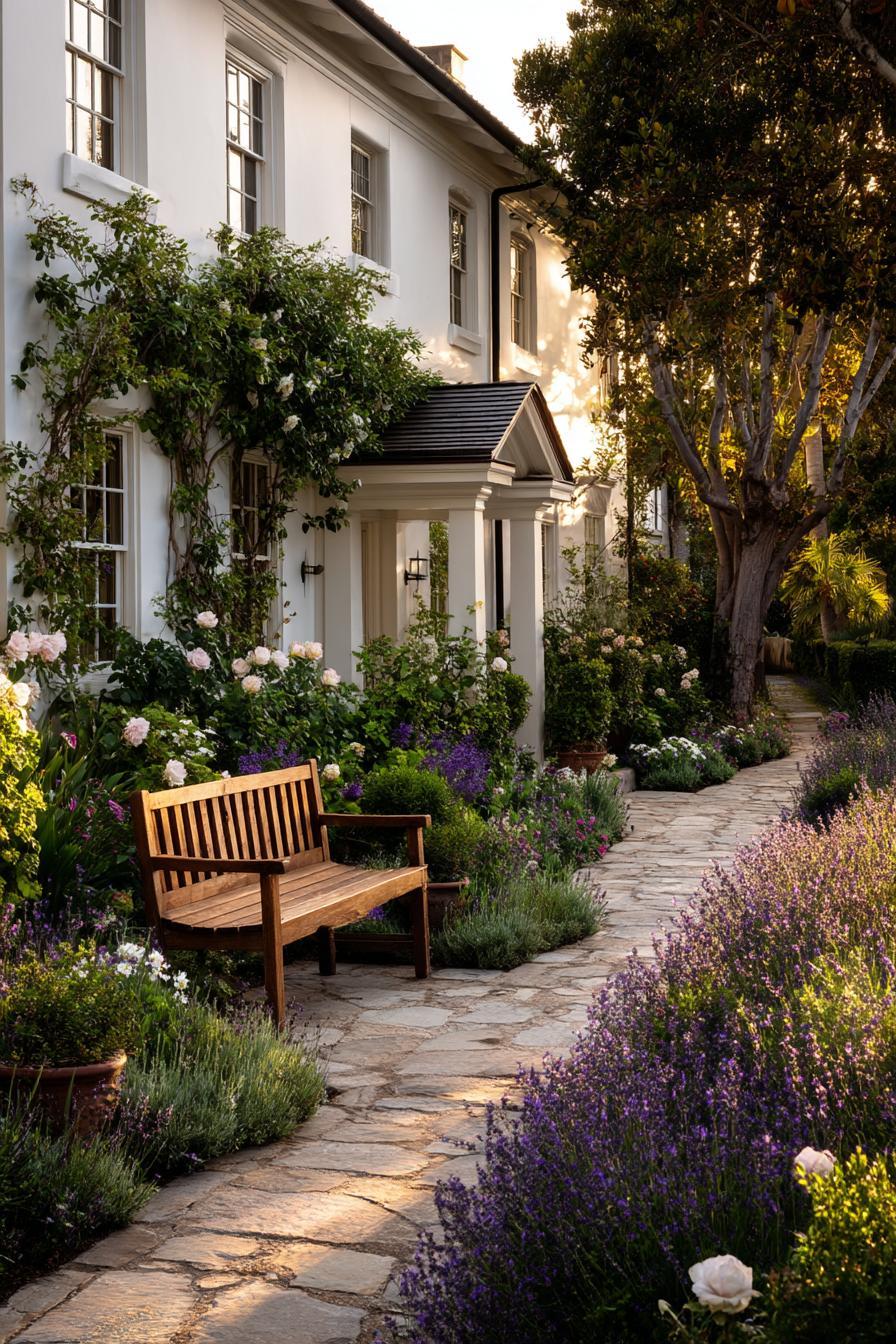
Appealing to more than just the eyes, fragrant flower beds create a sensory-rich experience for anyone approaching your home. Incorporating sweet-smelling blooms near doorways, walkways, or windows adds an invisible layer of comfort and charm that enhances curb appeal.
Opt for plants like lavender, roses, honeysuckle, jasmine, dianthus, and lilies. For continuous scent, stagger bloom times or mix in aromatic herbs like mint, basil, and thyme. Place these beds near seating areas or along paths to fully enjoy their fragrance.
Fragrant beds not only create a welcoming atmosphere but also attract pollinators like bees and butterflies. They’re particularly suited for cottage gardens, Mediterranean-inspired yards, or any home where scent and serenity are a priority.
20. Mixed Shrub and Flower Beds
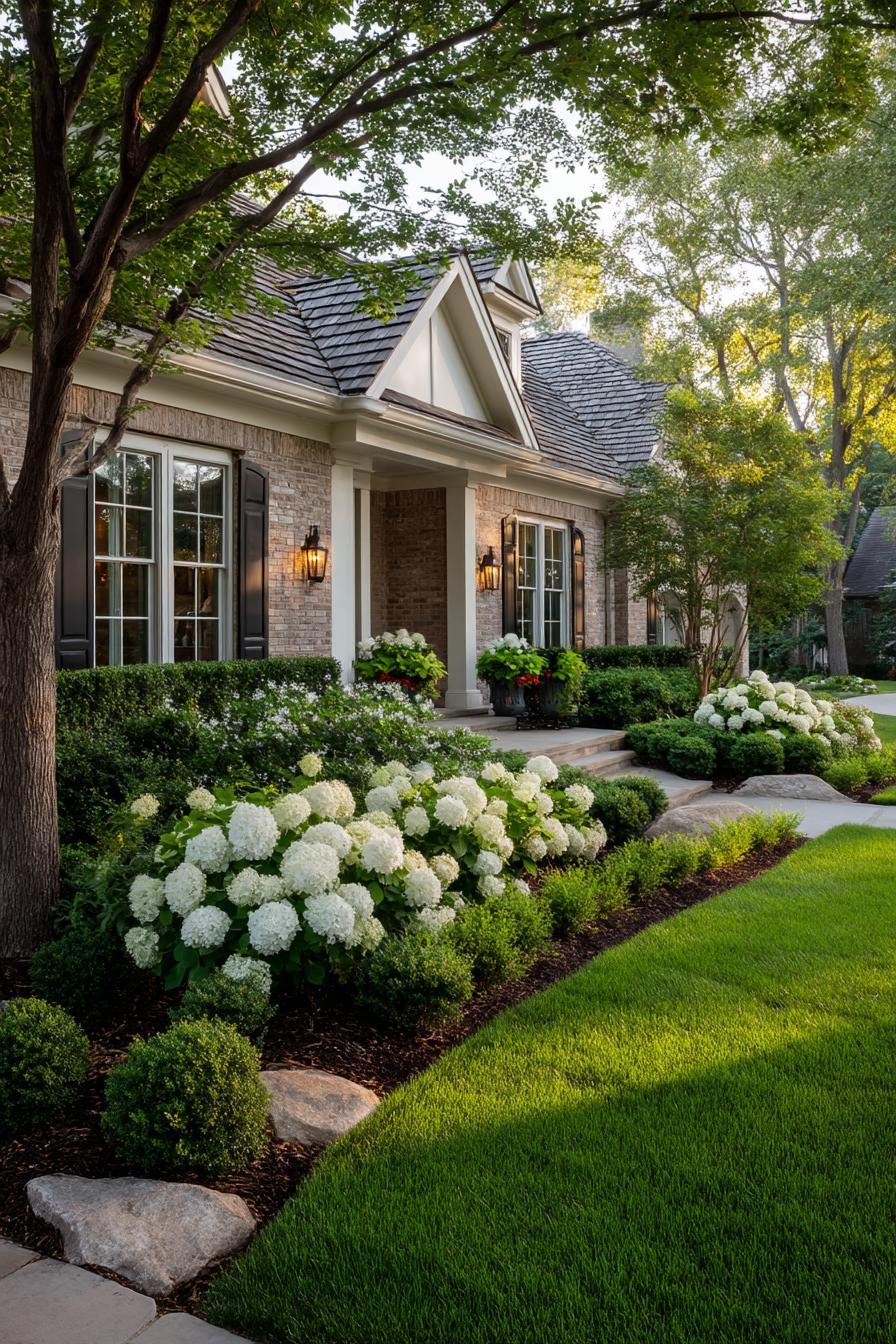
Combining flowering plants with evergreen and deciduous shrubs results in beds that offer structure, color, and texture all year long. Shrubs provide a permanent backbone to the landscape, while flowers offer seasonal variety and vibrancy.
Get the Fail-Safe Paint Color Playbook (Free PDF)
36 proven colors • 8 ready palettes • trim & sheen guide • printable testing cards.
Start with foundational shrubs like spirea, hydrangea, or boxwood, and intersperse them with perennials such as daylilies, asters, or salvia. Use ornamental grasses or ground covers to fill gaps and provide seasonal interest. This layered approach enhances visual complexity and offers dynamic color throughout the year.
Mixed beds work well along fences, house foundations, or standalone garden islands. They’re ideal for homeowners looking for a balanced, low-maintenance landscape that evolves beautifully over time.
Conclusion
A well-designed front-of-house flower bed does more than beautify—it welcomes, impresses, and expresses your personal style. Whether you’re drawn to the symmetry of formal beds, the carefree charm of wildflowers, or the bold personality of tropical or color-themed designs, there’s an idea here for every home, climate, and skill level.
By mixing heights, textures, and bloom times—or choosing a simpler palette and structure—you can create a front yard that’s both visually captivating and tailored to your lifestyle. Many of these ideas are scalable, making them perfect for everything from compact city plots to sprawling suburban lawns.
With thoughtful planning, seasonal refreshes, and a dash of creativity, your flower beds can offer year-round beauty, boost curb appeal, and transform the first impression of your home into a lasting one. Let these 20 ideas inspire your next garden project and help you plant the seeds of a front yard you’ll love coming home to.
